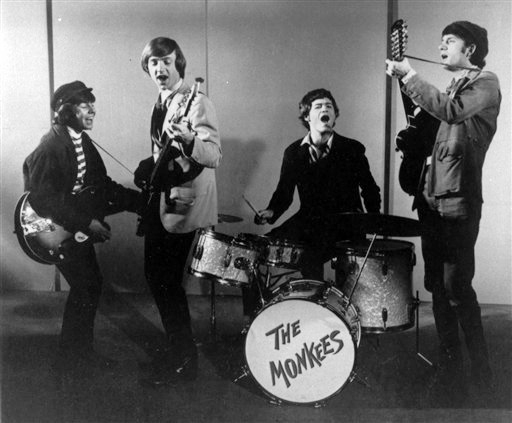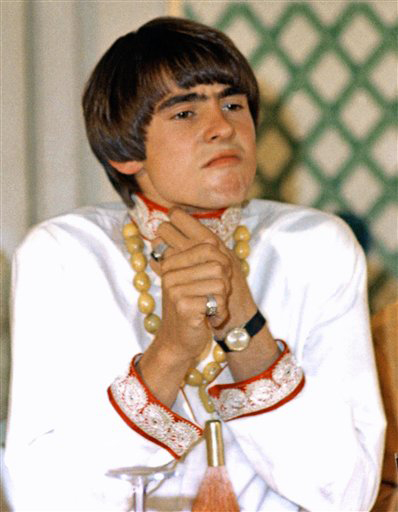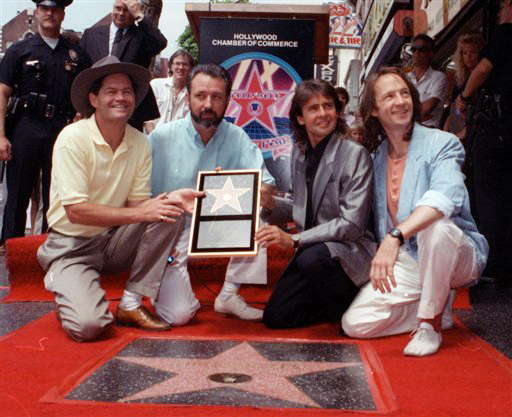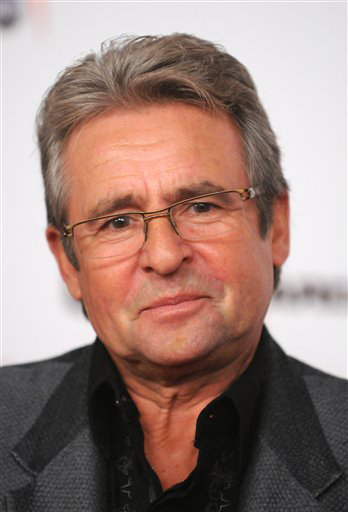WEST PALM BEACH, Fla. — Davy Jones, the diminutive heartthrob who rocketed to the top of the 1960s music charts by beckoning millions of adoring fans with the catchy refrains of The Monkees, died Wednesday. He was 66.
His publicist, Helen Kensick, confirmed that Jones died of a heart attack near his home in Indiantown. Jones complained of breathing troubles early in the morning and was taken to a hospital where he was pronounced dead, said Rhonda Irons, spokeswoman of the Martin County Sheriff’s Office.
In a 911 call released Wednesday night, an unidentified woman anxiously pleads “Ambulance, please, hurry!” His home was about 27 miles from the hospital and a fire rescue unit rushed him to the hospital.
Jones’ moppish long hair, boyish good looks and his British accent endeared him to legions of screaming young fans after “The Monkees” premiered on NBC in 1966 as a made-for-TV band seeking to capitalize on Beatlemania sweeping the world.
Aspirations of Beatles-like fame were never fully achieved, with the TV show lasting just two years. But The Monkees made rock ‘n roll history as the band garnered a wide American following with love-struck hits such as “Daydream Believer” and “I’m a Believer” that endure to this day.
Born in Manchester, England, on Dec. 30, 1945, Jones became a child star in his native England who appeared on television and stage, including a heralded role as “The Artful Dodger” in the play “Oliver.”
He earned a Tony nomination at 16 when he reprised that role in the show’s Broadway production, a success that brought him to the attention of Columbia Pictures/Screen Gems Television, which created The Monkees. Hundreds turned out for auditions, but the young men who became the Monkees had no idea what ultimately awaited them.
“They had an ad in the newspaper,” Jones recalled on NBC’s “Today Show” last year, “and then we all showed up.”
“The Monkees” was a band clearly patterned on the Beatle’s film “A Hard Days Night,” chronicling the comic trials and tribulations of a rock group whose four members lived together and traveled to gigs in a tricked-out car called the Monkeemobile. Mike Nesmith, Peter Tork and Micky Dolenz starred with him. Each part was loosely created to resemble one of the Beatles.
At 5-feet-3 inches, Jones was by far the shortest member of the group — a fact often made light of on the show. But he also was its dreamboat, mirroring Paul McCartney’s role in the Beatles. And as the only Briton among the four, Jones was in some ways the Monkees’ direct connection to the Beatlemania still strong in the U.S. when the TV show made its debut.
In August 1966, the Beatles performed in San Francisco, playing their last live set for a paying audience. The same month, the Monkees released their first album, introducing the group to the world.
The first single, “Last Train to Clarksville,” became a No. 1 hit. And the TV show would caught on quickly with audiences, featuring fast-paced, helter-skelter comedy inspired as much by the Marx Brothers as the Beatles.
It was a shrewd case of cross-platform promotion. As David Bianculli noted in his “Dictionary of Teleliteracy,” ”The show’s self-contained music videos, clear forerunners of MTV, propelled the group’s first seven singles to enviable positions of the pop charts: three number ones, two number twos, two number threes.”
Yet after the show’s launch, The Monkees came under fire from music critics when it was learned that session musicians — and not the group’s members — had played the instruments on their recordings. They were derided as the “Prefab Four,” an insulting comparison to the Beatles’ nickname, the “Fab Four.”
In reality, Jones could play the drums and guitar, and although Dolenz learned to play the drums after he joined the group, he also could play guitar, as could Nesmith.
Nesmith also wrote several of The Monkees’ songs, as well as songs for others. Tork, who played bass and keyboards on the TV show, was a multi-instrumentalist.
The group eventually prevailed over the show’s producers, including music director Don Kirchner, and began to play their own instruments. Regardless, the group was supported by enviable talent.
Carole King and Gerry Goffin wrote “Pleasant Valley Sunday,” and Neil Diamond penned “I’m a Believer.” Musicians who played on their records included Billy Preston, who later played with the Beatles, Glen Campbell, Leon Russell, Ry Cooder and Neil Young.
Young tweeted Wednesday that he was saddened by Jones’ death. “The Monkees were such a sensation that it was a thrill for me to have them record some of my early songs,” he added.
The group also released the 1968 film “Head,” derided at the time as a psychedelic mishmash notable only for an appearance by Jack Nicholson. It has since come to be considered a cult classic by Monkees fans.
After two seasons, the TV series had flared out and was canceled after 58 episodes in the summer of 1968. But The Monkees remained a nostalgia act for decades. And Jones maintained that the stage was the only place he truly felt at home.
“Even today, I have an inferiority complex,” he told the Daily Mail in an interview last year. “I always feel I’m there at the window, looking in. Except when I’m on stage, and then I really come alive.”
After the TV show ended, Jones continued to tour with the other Monkees for a time, sometimes playing the drums at concerts when Dolenz came up front to sing.
Many also remember Jones from a widely seen episode of “The Brady Bunch” that aired in 1971, in which he makes an appearance at Marcia Brady’s school dance. In the episode, Marcia Brady, president of her school’s Davy Jones Fan Club, promised she could get him to appear before her classmates.
The group eventually broke up over creative differences, although it did reunite from time to time for brief tours over the years, usually without Nesmith.
In 1987, Jones, Tork, and Dolenz recorded a new album, “Pool It.” And two years later, the group received a star on the Hollywood Walk of Fame. On Wednesday, flowers were placed on Jones’ own Hollywood star nearby as fans mourned.
All four of the Monkees came together for a 1996 album, “Justus,” and a subsequent TV movie “Hey, Hey, It’s The Monkees!” that saw them still living in the same house and still traveling in the Monkeemobile — just like old times.
Tork spoke of his former bandmate in an interview Wednesday night, saying “He was one of the funniest men and most talented I have ever known.” Nesmith said in a statement “David’s spirit and soul live well in my heart, among all the lovely people,” using a phrase from a Beatles song that seemed to again cement the two groups’ ties.
Jones, who is survived by his wife Jessica Pacheco and four daughters from previous marriages, continued to make appearances on television and stage later. But it was the fame of The Monkees that pulled him back to that era time and time again. On his website, he recalled during auditions for the show when all four men finally were put together in a scene.
“That’s it,” he recalled everyone around him saying: “Magic.”
Send questions/comments to the editors.





